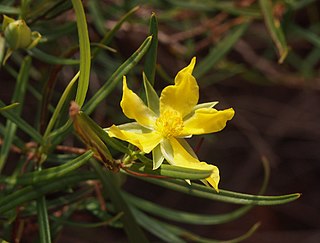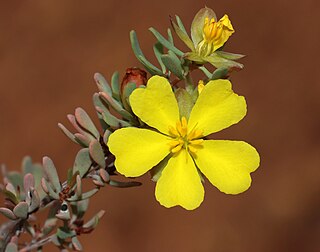
Hibbertia serrata, commonly known as serrate-leaved guinea-flower, is a species of flowering plant in the family Dilleniaceae and is endemic to the south-west of Western Australia. It is an erect shrub with softly-hairy foliage, elliptic to wedge-shaped leaves and yellow flowers with about twenty stamens arranged around two or three glabrous carpels.
Hibbertia acrotrichion is a species of flowering plant in the family Dilleniaceae and is endemic to a restricted area of Western Australia. It is a small, erect shrub with linear, cylindrical leaves and yellow flowers arranged singly in leaf axils with eleven stamens arranged in groups.
Hibbertia atrichosepala is a species of flowering plant in the family Dilleniaceae and is endemic to a restricted area in the south-west of Western Australia. It is an upright shrub with crowded linear to tapering leaves and yellow flowers arranged singly in leaf axils with glabrous sepals and the five stamens all on one side of the two carpels.

Hibbertia glaberrima is a species of flowering plant in the family Dilleniaceae and is endemic to Central Australia. It is a glabrous, spreading shrub with oblong to lance-shaped leaves and yellow flowers borne singly in upper leaf axils, with 30 to 150 stamens arranged around three carpels.

Hibbertia glabrisepala is a species of flowering plant in the family Dilleniaceae and is endemic to the south-west of Western Australia. It is an erect to sprawling shrub with linear to narrow oblong leaves and bright yellow flowers borne on the ends of short side shoots, with fifteen stamens in groups surrounding the five carpels.

Hibbertia glabriuscula is a species of flowering plant in the family Dilleniaceae and is endemic to the south-west of Western Australia. It is a small, erect shrub with thick, oblong leaves and yellow flowers borne singly on the ends of branchlets, with six to twelve stamens arranged around the two carpels.

Hibbertia glomerata is a species of flowering plant in the family Dilleniaceae and is endemic to the south-west of Western Australia. It is a much-branched shrub with mostly oblong or egg-shaped to elliptic leaves and yellow flowers borne on the ends of short side shoots, with nine to twelve stamens, sometimes in groups of three, arranged around the three carpels.

Hibbertia glomerosa is a species of flowering plant in the family Dilleniaceae and is endemic to the south-west of Western Australia. It is a shrub with linear to narrow oblong leaves and bright yellow flowers borne on the ends of short side shoots, with twenty-five to thirty-eight stamens arranged in groups of five around the five glabrous carpels.

Hibbertia hexandra, commonly known as tree guinea flower, is a species of flowering plant in the family Dilleniaceae, and is endemic to eastern Australia. It is a tall shrub or small tree with mostly lance-shaped leaves with the narrower end towards the base and yellow flowers arranged singly in leaf axils, with six stamens arranged around two hairy carpels.

Hibbertia leptopus is a species of flowering plant in the family Dilleniaceae and is endemic to Western Australia. It is an erect shrub with linear leaves and yellow flowers, usually with eleven stamens arranged around the three carpels.
Hibbertia monticola, commonly known as mountain guinea flower, is a species of flowering plant in the family Dilleniaceae and is endemic to south-eastern Queensland. It is a shrub with elliptic to egg-shaped leaves, and yellow flowers with many stamens arranged around three glabrous carpels.
Hibbertia notibractea is a species of flowering plant in the family Dilleniaceae and is endemic to the south-west of Western Australia. It is an erect, sprawling or prostrate shrub with linear to narrow elliptic leaves and yellow flowers with eleven stamens, nine in groups of three, arranged around three glabrous carpels.

Hibbertia oligantha is a species of flowering plant in the family Dilleniaceae and is endemic to the south-west of Western Australia. It is a shrub with linear leaves and yellow flowers with six to ten stamens on one side of two glabrous carpels.

Hibbertia porongurupensis is a species of flowering plant in the family Dilleniaceae and is endemic to a restricted area of the south-west of Western Australia. It is a glabrous shrub with broadly elliptic to more or less round leaves and yellow flowers arranged singly in leaf axils with large numbers of stamens arranged around five carpels.

Hibbertia priceana is a species of flowering plant in the family Dilleniaceae and is endemic to the south-west of Western Australia. It is a dwarf, usually compact shrub with erect, narrow elliptic leaves and bright yellow flowers with eleven stamens, nine in three groups of three, around three glabrous carpels.

Hibbertia rupicola is a species of flowering plant in the family Dilleniaceae and is endemic to the south-west of Western Australia. It is a shrub with densely-clustered, linear leaves and yellow flowers with nine to seventeen stamens arranged around three glabrous carpels.
Hibbertia scopata is a species of flowering plant in the family Dilleniaceae and is endemic to the Northern Kimberley region of Western Australia. It is a small shrub with wiry branches, lance-shaped leaves with the narrower end towards the base, and yellow flowers arranged singly along the branches, with thirteen to fifteen stamens arranged in groups around two densely scaly carpels.

Hibbertia squarrosa is a species of flowering plant in the family Dilleniaceae and is endemic to the west of Western Australia. It is an erect shrub with linear leaves and yellow flowers with twenty stamens arranged around five glabrous carpels.
Hibbertia suffrutescens is a species of flowering plant in the family Dilleniaceae and is endemic to the Northern Kimberley region of Western Australia. It is a small shrub with wiry branches, narrowly lance-shaped leaves with the narrower end towards the base, and yellow flowers arranged singly along the branches, with 30 to 36 stamens arranged in groups around two densely scaly carpels.
Hibbertia turleyana is a species of flowering plant in the family Dilleniaceae and is endemic to a small area in the south of Western Australia. It is a low-lying shrub with more or less glabrous, linear leaves and bright yellow flowers with eight or nine stamens in a single group on one side of two densely hairy carpels.














